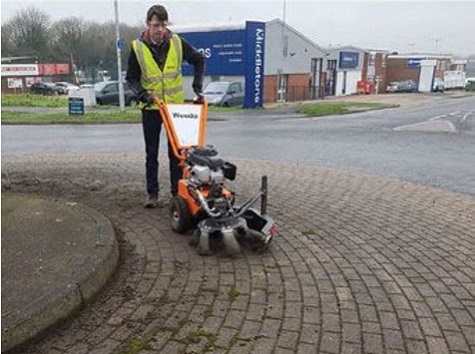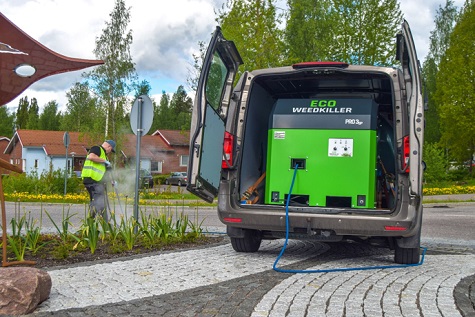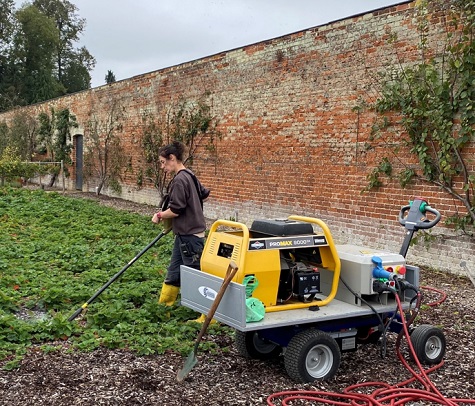

In addressing the need for sustainable practice, core to any actions is taking an integrated approach but what does that mean? Just as with the term sustainability, it is important to understand what is meant by an integrated approach and importantly what is not.
Firstly, we should review the various tools we might draw upon to create the most appropriate integrated approach in any given situation.
For any particular weed management plan, the right combination of techniques and approaches is important. In other words, the options discussed are not either or but part of an integrated approach.
For weed management, these have been divided into the following categories:

Mechanical brush courtesy of Kersten
This article addresses the first three in some detail.
Manual & Brushing
Manual operations
Pulling, cutting, and otherwise damaging plants, may be used to control some weeds, particularly if the population is relatively small. However, it is generally labour and time intensive. Treatments must typically be administered several times to prevent the weed from re-establishing and in the process, workers and machines may severely trample vegetation and disturb soil, providing prime conditions for re-establishment of the same or other weeds.
Pulling or uprooting plants can be effective against some shrubs, tree saplings, and herbaceous and floating weeds. Annuals and tap-rooted plants are particularly susceptible to control by hand-pulling. It is not as effective against many perennial weeds with deep underground stems and roots that are often left behind to re-sprout.
Mowing, brush cutting and strimming
Mowing and cutting can reduce seed production and restrict weed growth, especially in annuals cut before they flower and set seed. Some species, however, re-sprout vigorously when cut, replacing one or a few stems with many that can quickly flower and set seed. It is important to consider the biology of the weed before cutting. If mowed earlier, native species are negatively impacted.
Powered sweeping machines and weed brushes
Brushing plays a very important part in weed control of highways, pedestrian walkways, car parks, parks and gardens as part of an integrated management approach. Modern powered sweepers are highly sophisticated and can operate on a variety of hard and delicate surfaces. Weed brushes can only work on hard surfaces and may damage delicate or soft surfaces. They remove detritus from the surface, depriving weeds of the required growing medium, damage the leaf, reducing ability to photosynthesise and in some situations, it can remove the whole weed plant including the root.
There are no potentially harmful residues left that may expose humans or wildlife to risk of danger although some harder brushes may create sparks on hard surfaces with some risk of causing fire. Any sweeping or brushing needs co-ordination with other methods used for weed control, such as the application of plant protection products. Also, effectiveness of the approach relies significantly upon the competence of the operator and the design of the surface. There is no doubt that an effectively managed sweeping regime can prevent weed growth and, in treating weeds, be a core element in an integrated approach.
Thermal methods of managing weeds
Application of hot water
Temperatures of approximately 100°C are applied for the duration of a few seconds, resulting in intracellular water expansion and cell membrane rupture. Several biological and technical factors, including the weed type and their stage, soil properties, and energy consumption of the system, influence the practicability and sustainability of these thermal weed control options. Weeds are wilted to the root upon contact breaking down cellular structure of the plant, melting the cuticle of the leaf, preventing the plant from retaining moisture, thus dehydrating and then killing the plant. No legislation restricts the use of hot water as a method of weed control and no specialist clothing or hearing protection is required, although when operating a hot water machine, training is a requirement under the Provision and Use of Work Equipment Regulations (PUWER)

Photo courtesy of Kersten
Hot water machines offering lower risk of non-target plant damage, can be utilised on all surfaces, but perform better on hard surfaces and can be seen as a more environmentally friendly method for managing weeds. However, there are carbon emission issues in their use of fuel to heat up water and power machines. The method can have a high carbon footprint when examined in a life cycle analysis and, with the need for more frequent use compared to other methods, the total costs need to be carefully examined.
Hot water is only effective on contact with weeds, if the hot water does not touch part of the weed it may survive. It does not always kill down to the roots, so will not necessarily eradicate the weed completely. Many hot water machines have long hoses and so by the time the hot water touches the weed it may have cooled and be less effective although design features continue to rapidly develop. Accessibility of areas such as alleyways can also restrict effectiveness. Repeat treatments will be necessary after regrowth; there is no residual effect.
Application of hot foam
These machines use hot water insulated by foam. It is the heat in the hot water that kills the weeds. Environmentally friendly foam, made from natural plant oils and sugars, acts as an insulation blanket over the top of the hot water ensuring the heat is not lost as quickly to the atmosphere. Heat from the hot water is “trapped” on the plant for longer, by the foam, thus giving more time for the heat to work on the weed. Heat penetrates the plant’s waxy outer layer of the leaf, travels down the stem, into the root system, effectively cooking the plant. Hot foam can also kill some surrounding seeds and spores to reduce future regeneration. No specialist clothing or hearing protection is required. Training is a requirement under PUWER.
Benefits include that they can be used in all weather conditions, on any surface, all year round. They are easy to use for operators and simple to get up and running and relatively safe for use around people, animals, delicate ecosystems and waterways. They do not damage the soil surface and can be ideal for sensitive environments. Limitations include different surfaces may require greater numbers of treatments dependent on pre-existing weed growth, with no residual effect. Hot foam requires capital investment in the hot foam generation machine although contractors can be used. More frequent control of weeds will be needed with re-growth of weeds after treatment. As with hot water, the method can have a high carbon footprint when examined in a life cycle analysis) with a need for more frequent use compared to other methods such as herbicides.
Weed Burner Equipment
Many weed burners consist of infrared radiation in combination with heated air. When plants are exposed to this combination, the proteins congeal and moisture cells burst open at about 70°C, then the plant wilts and subsequently dies. Weed burners diminish the likelihood of germination of seeds on the ground, thus reducing regrowth. Infrared radiation only penetrates the ground a short distance, and repeated treatments are needed to deplete the plant reserves in the root system reducing regrowth capability. No legislation restricts the use of weed burners and infrared radiation as a method of weed control, but training is a requirement under PUWER.
In terms of benefits, many weed burners are easy to operate as hand operated machines and can be used in the wet, thus are less dependent on weather. They provide Instant visual results and control most grass types, annual and biennial plants and young perennial weeds. As compared to flame throwers, they produce less risk of creating unwanted fires. Limitations can include being quick to work, but slow to apply, best at a slow walking pace and the level of carbon emissions from the machine used can be high. They are non-selective in control and will kill non-target species, therefore generally not suitable for spot treatments due to width of the weed burner. They only remove weeds on the surface with most of the root system surviving so frequent use is needed and they should not be used on particularly dry, flammable vegetation.
Electricity

Photo courtesy of Kersten
This involves use of hand lances to deliver an electric charge to the weed targeted. It uses natural resistance of weeds to convert electrical energy into heat, which then boils and so kills the weed from the inside out from the root upwards. Operator training is required under PUWER and for electrical safety. In terms of benefits, using electricity within the weed ensures all of the plant is treated from root to the tips of the leaves. Electricity can be used for all weed types, including tough invasive species. The process is localised to the plant in contact with the lance and does not damage surrounding plants or soil. Electricides treat deep into the roots making it suitable for treating any weed, including tough invasive species. It can claim environmental benefits – organic, no surfactants, no active ingredient chemicals, no additives, nor residues. Treated areas are safe to return to immediately after treatment. Fewer retreatments may be required than in thermal methods.
Limitations include that it cannot be safely used when raining and can prove unsafe on hard areas as a safety earth return spike is required in the ground. Caution is required when treating around conductive materials. Operation can be relatively slow as electrical current has to be applied to each weed plant
Conclusion
Technological advances are taking place all the time which may impact upon some of the comments in this article but hopefully it has sought to give a factual account of each method. Next month we will complete this review of options available before addressing the issue of drawing up an integrated plan for a specific situation involving deciding upon the correct approach to take both in prevention and control.
Editorial Address:
LandPower Publications LLP, Howbery Park, Benson Lane, Wallingford, Oxfordshire, OX10 8BA
Telephone:
Steve Gibbs: +44 (0)7929 438213
